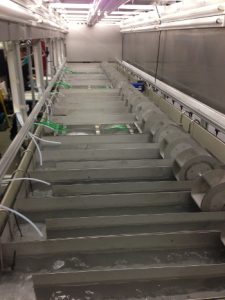In this new series of posts we present you some of the equipment and facilities we use to assess the fate and environmental impacts of chemical stressors. We start with the Landau Laboratory Stream Microcosm Facility.

View over the Laboratory Stream Microcosm Facility (photo by J. Zubrod).
The working group Ecotoxicology & Environment hosts a state-of-the-art stream simulation system consisting of 24 stainless-steel artificial stream channels (120×30×20 cm3; water volume ≥40 L). In each stream channel, a pedal wheel facilitates a continuous water movement simulating running water conditions. The stream channels are supplied continuously with test medium of desired composition, which is provided on demand. The test medium can be dosed with chemical stressors using independent technical control units that supply four channels with the same “treatment” at a time. It is thus possible to simulate customized peak exposure scenarios but also constant low dose exposures supporting the risk assessment of pesticides, biocides, pharmaceuticals, nanomaterials and other chemical stressors. The stream units are situated in a water bath allowing strict temperature control. The lamp system above the streams is designed to support macrophyte growth and can simulate nearly the whole natural wavelength spectrum including UV-A and UV-B. Generally, the system is suitable for short- and long-term experiments lasting up to several months to simulate stream environments with all major components, namely water, sediment, macrophytes, and a wide range of invertebrate species.
This unique testing facility enables complex ecological and ecotoxicological studies under highly controlled environmental conditions. Thus, it was already used in a range of research projects to assess the environmental impacts of genetically modified crops, fungicides, nanomaterials, and systemic insecticides and is scheduled for ongoing research currently funded by the DFG, namely AQUA-REG and INTERNANO.
